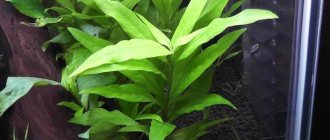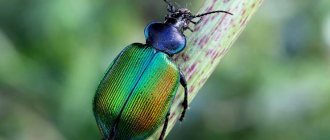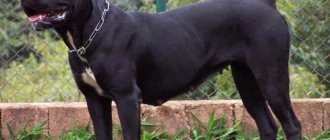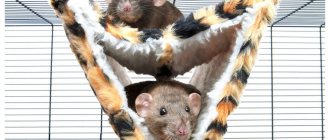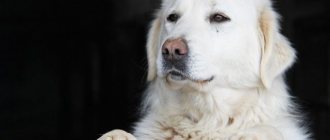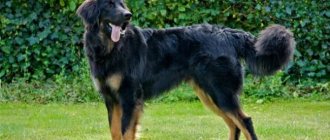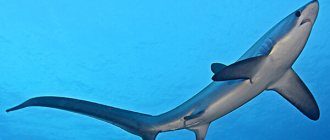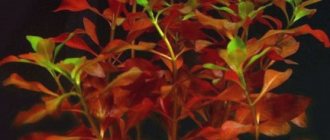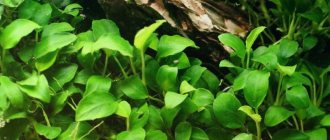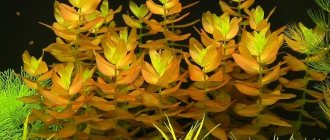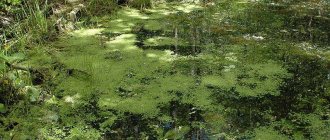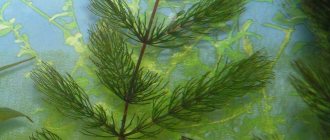Having moved from rice fields to aquariums, it has transformed from a weed into an herbalist's ornamental ornament.
This democratic culture is suitable for landscaping aquariums of all types and sizes. In loose transcription, “hygrophila” is romantically translated as “filled with water.” All varieties grow rapidly, as befits weeds, and can quickly revitalize the underwater landscape.
This species not only imitates the outline of willow leaves, but also does the important job of purifying the aquatic environment. With the help of leaf blades, Hygrophila absorbs organic matter and inorganic elements dissolved in water.
Hygrophila looseleaf is a narrow-leaved cultivar of H Hygrophila corymbosa. In the aquarium hobby it is not as widespread as the related H. corymbosa varieties “siamensis” and “stricta”.
Plant morphology
Hygrophila willow is a spreading plant, reaching a height of up to 40 cm, in rare cases up to 60 cm. The length is limited by the height of the aquarium.
Main characteristics:
- Department – Flowers
- Class - Dicotyledons.
- Order - Polyfeathers.
- Family - Acanthus.
- Genus - Hygrophila.
- Flowers - white, purple, light blue. Located in the axils of emergent leaves.
- The leaves are linear, narrow, smooth or jagged along the edges, up to 12 cm long and up to 10 cm wide. The color range varies from pale green to emerald. The lower part of the leaf blade is lighter. Under bright light it turns brown. The reverse side is silver.
Compared to other varieties, it develops a more powerful root system.
Description
Hygrophila angustifolia has gained great popularity due to its ease of care. This plant is most often used to create aquatic design, because it is inexpensive and is sold in appropriate stores.
This plant is most often used for aquadesign.
The leaves are bright green, less often dark green. Very similar to willow leaves. Thanks to this similarity, the plant got its name.
The stem has a bright red tint. It is tough and dense at the same time. In the direction of growth it tends upward. Most often the stem reaches a length of 40 or 50 cm.
Very rarely, hygrophila can bloom. This phenomenon occurs when the water temperature reaches 25-27 degrees Celsius. The inflorescences of this plant are located above the water column.
Growing and care
The plant grows well in tall aquariums. Although it is not classified as difficult to care for, there are still a number of recommendations for growing:
- Can be used to create bottom support during spawning. This measure protects the eggs from being eaten by fish.
- If the crop is not under water, it should be protected from direct sunlight.
- In intense overhead lighting, hygrophiles act as a natural light filter that reduces the risk of water blooms.
- It is desirable that the long stems of the plant are hidden under water. When above water it demonstrates its best decorative qualities. The cut fragment can be used as fertilizer for indoor crops.
- When pruning, it is important to control the cut line; it should be higher than the previous one.
- Plants grown in a nursery often have difficulty adapting to new conditions.
The graceful elongated foliage of Hygrophila loosestrife looks good in large aquariums in the vicinity of broad-leaved or round-leaved crops.
It is equally beneficial to place plants in separate groups in the center. The decorative qualities are enhanced in herbals with a gentle current, which highlights its beautiful wavy foliage.
Optimal water parameters
The plant quickly adapts to new conditions and can easily tolerate temperature drops below 20°C and above 26°C.
Recommended settings:
- temperature - 20-26°C;
- hardness - 8-10° dH;
- pH - 7-8;
- NO3 - 10-15ppm;
- PO4 - 0.5-1ppm.
A weekly water change of 25% of the total volume is required. Also, don't forget about filtering.
Lighting requirements
- Intense lighting of 70-100 Lm/l for up to 12 hours is preferable, calculating 0.5 W per 1 liter of water. When exposed to bright light, the leaf blades acquire an interesting brown or bright red hue. Despite the love of these aquatic beauties for light, they calmly tolerate long-term shading. But with a lack of lighting, the leaves become smaller and the stem becomes elongated.
Soil requirements
- Despite the fact that this plant can be grown without soil, fixed, for example, on driftwood, it is advisable to take care of the quality of the soil. This is necessary to create comfortable conditions for other aquarium crops. The nutrient base can be formed from coarse river sand with a fraction of 4 mm, medium-grained sand with a fraction of 2 mm and fine gravel. The recommended thickness of the 1st layer is 2 cm, the 2nd layer is 4 cm, the 3rd layer is 2 cm.
The need for feeding
Hygrophila loosestrife receives all the necessary nutrients from water.
To give the plant an aesthetic appearance, it is advisable to regularly feed it with liquid fertilizer.
You can use industrial mixtures. They are well balanced in composition, which eliminates the need to independently calculate the concentrations of nutrients.
Tropica Premium Nutrition fertilizer is popular among aquarists. It does not contain phosphorus and nitrogen and is enriched with manganese and iron. It is enough to add 6 ml per 50 liters of water once a week.
A little about the soil
For the successful growth of hygrophila loosestrife in an aquarium, it needs a certain amount of sludge. For its spontaneous formation, sand or the finest gravel is required, the fraction of which should not exceed 0.6 mm. When planting, for better survival, it will be wise to place a piece of clean clay under the root. The soil layer is at least 3 cm, and preferably 5. If such a thick layer is unnecessary (for aesthetic reasons or due to the characteristics of the fish population), then the willow hygrophila is planted in shallow pots. True, this will prevent its growth. However, in a single landing it also looks very impressive.
Features of reproduction
Propagated, like most long-stemmed crops, by cuttings. To perform this manipulation, you need to divide the plant stem into several cuttings. It is advisable that each fragment have at least 6 leaves.
Plants should be planted in the soil in groups of 6 shoots. It is preferable to plant at the side or rear walls. For experimental purposes, you can try to separate a rooted bud from a floating hygrophila, on which several leaves have already formed. If you transplant this shoot into the ground, perhaps it will take root. The average growth rate of hygrophiles is from 2 to 5 leaves per month.
Diseases
Unfortunately, hygrophiles can be susceptible to certain diseases:
- If care is not carried out correctly or aquarists do not control the growth of hygrophila, the plant can grow widely. Thus, it will not only take away space from other inhabitants of the aquarium, but will also rise above the surface of the water. Hygrophila is very susceptible to bright rays of light; they burn its leaves. To avoid such unpleasant situations, it is better to trim the upper leaves that appear above the surface of the water in a timely manner.
- If the plant has weakened and the leaves have become yellow and lifeless, then it is necessary to check whether the water parameters correspond to the required ones. Check hardness and acidity levels. Compare the results with the standard requirements. Based on the result, you can understand what caused the hydrophila disease. As soon as the parameters are returned to normal, the plant will begin to recover slowly but surely.
- If the leaves darken, resembling brown algae, it is necessary to reduce the lighting power from artificial lamps. It is better to give the plant the opportunity to receive scattered natural sunlight.
Hygrophila needs to be pruned. But this should only be done with sharp scissors. It is recommended to make the incision at an angle, higher than the previous one.
Hygrophila must be trimmed with sharp scissors
If you neglect this rule, you will eventually see that the plant weakens and becomes lifeless.
Name variations
Hygrophila loosestrife is also known as:
- hygrophila elongated;
- hygrophila corymboses;
- Hygrophila corymbosa;
- nomaphyla straight;
- Hygrophila angustifolia.
In everyday speech it is often called lemongrass.
Habitat indicator
Hygrophila compact is a good environmental indicator. By appearance you can understand which microelements it lacks.
If there is not enough potassium, then the external signs of the plant will appear as follows:
- Small holes will begin to appear on the leaves, most often the lower ones;
- New leaves will begin to grow smaller in size;
- The leaves begin to curl, become deformed, the lower ones and completely fall off;
- Leaf blades turn yellow;
- Slowly growing;
- The tops are dying off.
With a lack of phosphorus, the following occurs:
- New growing leaves become dark green with a reddish tint.
Useful lifehacks
To ensure that Hygrophila Ivolistna pleases the eye with neat, beautiful thickets, we offer you some useful tips:
- With the help of hygrophiles, you can clean the aquarium from waste products of underwater animals.
- If the plant does not want to take root and constantly floats up, you need to tie it to a stainless nut, use a glass rod or a stone with a drilled hole.
- Hygrophila loosestrife looks good in the vicinity of ceratopteris, ludwigia, rotala macrandra and alternanthera. These crops have similar conditions. In addition, they form beautiful thickets in the background. The long, lanceolate, light green leaves contrast elegantly with the darker, rounded foliage found on Anubias.
- Small holes on older leaves indicate a lack of potassium, white growths indicate iron deficiency, and premature yellowing indicates a lack of nitrates.
- If you have difficulties with rooting, you can use Seachem Flourish Advance. It contains phytohormones beneficial to roots, which stimulate the growth of the root system.
Conditions in the aquarium.
Sinema is an unpretentious aquarium plant; it develops well in soft water of 4 degrees. with an acidic reaction pH 5.0-5.5, and in hard water, 16 degrees. with an alkaline reaction pH 8.5. The water temperature for sinema is suitable in the following range from 22 C to 27 C; at a water temperature below 22 C, the growth of hygrophila practically stops.
In an aquarium, the blue one can be planted in the ground, or it can be left floating; in both cases, the plant will develop normally. The plant does not require additional feeding; the blueberry plant has enough nutrition obtained naturally, although of course the application of fertilizers, good lighting and the supply of CO2 (carbon dioxide) will have the most favorable effect.
Spreading
The main habitat is the reservoirs of Southeast Asia. The plant is often found in marshy areas, making it well suited to paludariums or wet greenhouses.
Dweller Compatibility
It is not recommended to place Hygrophila in an aquarium containing large snails. The reason for this is that these inhabitants are very fond of this plant and can strongly pluck the leaves. Especially in this regard, the Achatina snails, as well as Neretina, “differ.” A good symbiosis is formed by hygrophila and small schooling fish. They do not eat the plant, but view it as a shelter and often lay eggs there. This group of fish includes guppies and swordtails. Hygrophila can also serve as a home for fry that need shelter in the initial period of their life.
The plant is also suitable for bottom-dwelling fish. They do not really like to move around the aquarium and spend most of their time buried in the ground. A prominent representative is the catfish. The overgrown rhizome of Hygrophila becomes a good and reliable home for such fish.
In general, the presence of hygrophila in an aquarium has a beneficial effect on its inhabitants - due to the fact that the water is purified, the likelihood of fish getting sick is slightly reduced. It should also be noted that saturation of water with oxygen cannot but have a beneficial effect on the well-being of fish. Some aquarists use cut leaves of hygrophila as a kind of substrate. It can serve as a place for laying eggs during spawning.
Cut leaves can also be used as fertilizer for indoor plants.
How to propagate lemongrass
Nomaphyla propagates by cuttings. It's very easy to do this:
- The upper shoots are carefully trimmed from a healthy plant.
- The cuttings are placed in separate containers (it is better to use clay pots) and placed in the soil of the aquarium.
- As soon as the shoots take root, the crop is transferred to permanent residence.
You can let the cut cuttings go into the water area for “free swimming”. But in this case, the upper leaves of the crop will actively reach towards the light. Because of this, the spine takes on an irregular, curved shape (this defect cannot be corrected).
Pruning the top shoots of Schisandra does not harm the crop. On the contrary, such a procedure leads to an increase in the lushness and density of foliage.
